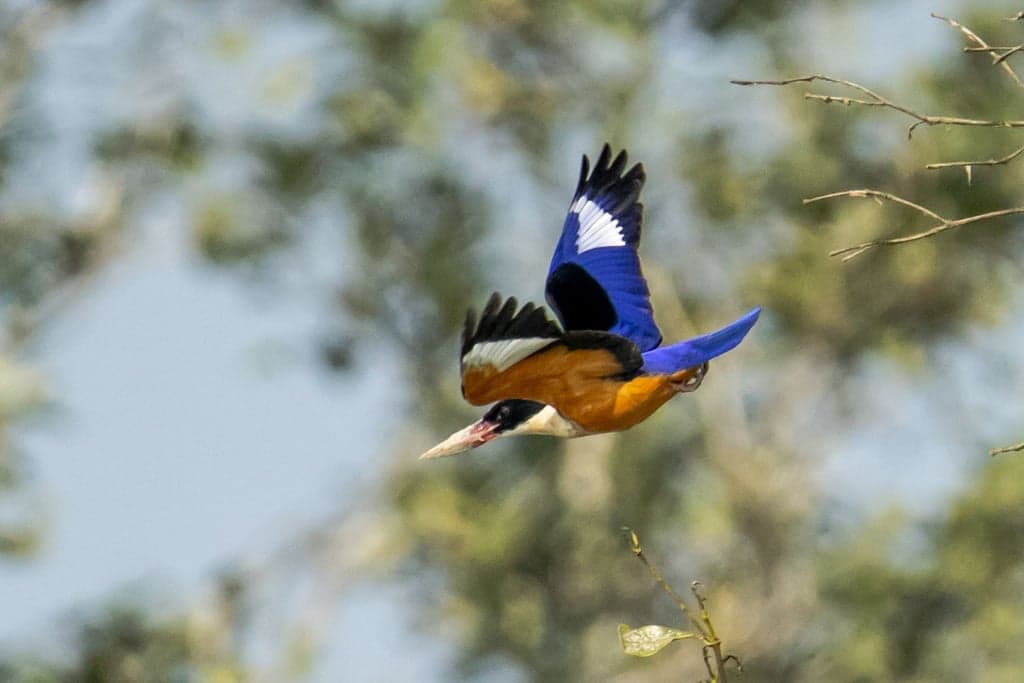
This was my second visit to the Sundarbans! This incredible mangrove forest, just a day trip from Kolkata, is a UNESCO World Heritage site and the largest of its kind in the world. It's a haven for birdwatchers, with over 300 species calling it home, including the colorful kingfishers and the impressive Oriental Pied Hornbill. Winter is the ideal time to visit, with pleasant weather and the chance to spot crocodiles basking in the sun. While the majestic Royal Bengal Tigers are notoriously difficult to find, the abundance of birdlife makes the Sundarbans a truly unforgettable experience, especially for returning visitors like me.

The Journey Begins
We reached Godkhali by around 10 a.m., slightly late and a bit road-weary but excited. The drive from Kolkata along the Basanti Highway takes you through bustling towns, vast agricultural fields, and stretches with brick kilns. As you approach the Sundarbans delta, fisheries become prominent. The road, though well-maintained, is quite busy and congested, offering a smooth yet bustling journey. Along the way, we spotted small ponds and brick kilns, adding to the rural charm of the landscape.
After a quick stretch, we boarded our boat, and our journey into the heart of the mangroves began.
Our guide introduced us to the ecosystem we were about to explore. We learned that the mangroves are vital, not only as a habitat for wildlife but as a buffer against tidal surges and cyclones. The water was brackish, and we could see that every inch of this landscape thrived on the balance between saltwater and freshwater.

The Unique Ecosystem of the Sundarbans
The Sundarbans, meaning "beautiful forest", is the world's largest coastal mangrove forest. Located where the Ganges River meets the Bay of Bengal, it spans approximately 9,630 sq km, with 4,000 sq km on the Indian side and 5,630 sq km in Bangladesh. This unique ecosystem comprises 102 islands in India, of which 54 are inhabited. Mangroves are the dominant vegetation, and the Sundarbans are home to 84 varieties. They are specially adapted to survive in the region's saline water and tidal fluctuations. Their aerial roots, which stick out above the water level, are a remarkable landscape feature. The Sundarbans gets its name from the ‘Sundari’ mangrove tree, more common on the less saline Bangladesh side.

The Royal Bengal Tiger is the most iconic inhabitant of the Sundarbans, but sightings are rare. These tigers have adapted to the challenging environment, becoming strong swimmers to navigate the waterways. Each island has a dominant male tiger and several females, each with their own territories marked by urine. Other mammals found in the Sundarbans include spotted deer, wild boar, leopard cats, fishing cats, jungle cats, Rhesus macaques, Asian palm civets, Asian small-clawed otters, and fulvous fruit bats. All mammals in the Sundarbans are adept at swimming to survive the fluctuating water levels. The Sundarbans is also a haven for birds, with over 300 species recorded. The abundance of insects, fish, crustaceans, and fruits provides a year-round food supply, attracting a diverse range of birds, including many kingfisher varieties. Migratory birds, such as sandpipers, plovers, and ospreys, visit during the winter months, adding to the avian diversity.
Birdwatching Adventure
The best time for birdwatching is during winter (November to March), when migratory birds escape colder climates and seek refuge in the Sundarbans, taking advantage of the abundant food and shelter. Migratory birds include species like sandpipers, plovers, and ospreys.
Popular Birdwatching Hotspots in the Sundarbans
Sajnekhali Bird Sanctuary: A must-visit for bird lovers. A watchtower provides an expansive view of the surrounding water channels, where you might spot herons, egrets, ibises, fishing eagles, and the Oriental Pied Hornbill.
Netadhopani: Known for its birdlife and historical significance, with the ruins of a 400-year-old temple. You can see pelicans, darters, and cormorants in this area.
Dobanki Watchtower: An ideal location to spot various kingfisher species, including the collared, brown-winged, and black-capped kingfisher. You might also see the mangrove pitta or the masked finfoot.
Sudhanyakhali Watchtower: Offers panoramic views of the Sundarbans, providing opportunities to see the stork-billed and pied kingfishers, as well as the magpie robin.
Our big reveal came when we spotted a lesser adjutant stork, a majestic and somewhat rare bird. The thrill of catching such a sight through the lens was unmatched!

Birds of Sundarbans






Elusive Tiger, Enduring Memories
Spotting a Royal Bengal Tiger in the Sundarbans is tough because of the shifting tides, dense mangrove cover, and the tigers’ constant movement. They don’t have fixed territories here, and the waterlogged, tangled landscape makes tracking nearly impossible. With their elusive nature, catching a glimpse truly takes luck! Yet, the experience of gliding through this beautiful, untouched landscape was a reward in itself. The serene waterways, the whisper of the mangroves, and the vibrant birdlife left us all in awe.
Lunch was a perfect mix of local Bengali flavors, fresh fish, and warm, home-cooked dishes right on the boat. As we drifted through the mangroves, the gentle rocking added to the coziness of the meal, turning it into a memorable experience with nature as the backdrop. It was simple yet delightful—a celebration of flavors and the beauty around us.
As we sailed back to the dock, I felt grateful. The Sundarbans lived up to every expectation and more, offering a rare blend of adventure and peace. This short trip reminded me of the wonders close to home and the joy of rediscovering nature with family. The memories we made on this trip will undoubtedly last a lifetime.
Tips for a One-Day Trip to the Sundarbans from Kolkata
Start Early: Aim to reach Godkhali by 8a.m. to maximize your day.
Visit in Winter: November to March offers ideal weather and great birdwatching with winter migratory birds.
Set Realistic Expectations: Tiger sightings are rare; focus on the birds, mangroves, and scenic beauty.
Bring Binoculars: Essential for spotting the diverse birdlife, including kingfishers and hornbills.
Try Local Fish: Enjoy a fresh Bengali-style meal onboard for an authentic experience.
Dress Comfortably: Light clothing, a hat, and sunscreen are must-haves for a day in the sun.
Pack Snacks and Water: Handy for the long journey to and from Kolkata.
Stay Eco-Friendly: Avoid single-use plastics and carry your waste back with you.
